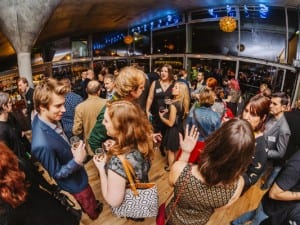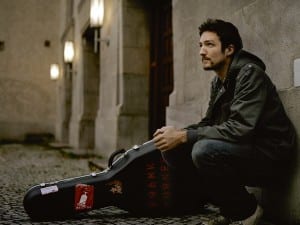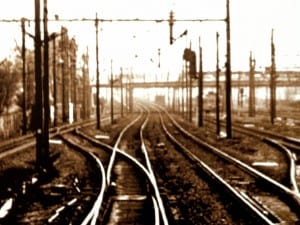Catherine Yass’s latest exhibition amalgamates social ideals with the awe-inspiring precision of high-wire artist, Didier Pasquette.
Walking in the air, defying gravity and weightlessness, combined with a retrospective on Glasgow’s modernist constructions, are concepts that are explored in Catherine Yass’s High Wire. Since completing her MA at Goldsmiths in 1990, Yass has enjoyed an illustrious career, which has seen several solo exhibitions and a nomination for the Turner prize in 2002. Her latest achievement explores the egalitarian aspirations of social housing in the 1960s and their reality today.
Comprising of a four-screen film installation, and back-lit images, High Wire intertwines the artist’s fantasies of a gravity-defying amble, with welfare-state social ideals to address Britain’s acute 1960s housing problems. Acclaimed French high-wire artist, Didier Pasquette, attempts the shaky feat of navigating across the lofty wire strewn between two tower blocks of social housing on Glasgow’s Red Road Estate. The largest and highest of its kind upon its inception in 1963, the Red Road Estate was fitting for Yass, as it represented a new “pioneering spirit about housing policy and socialism and modernism, and about building a better world.”
Following on from her 2002 piece Descent, whereby a video camera was gradually lowered from Canary Wharf’s skyscrapers, High Wire continues Yass’s preoccupation with altitude, flight and unachievable dreams of sky walking. “I was interested not only in the dream of walking in the air, but also sort of broader, wider social dreams. I was thinking about utopias or dreams of better societies, which are higher in the air.” Social housing experiments are a prominent feature of the Glaswegian landscape and the constructions aspired to improve the quality of life of all, providing a comprehensive system of homes for the worse off, with indoor bathrooms, central heating, and rejuvenated community spirit. Tower blocks such as Red Road soon became associated, however, with worse issues of social unrest and poverty than those which they sought to resolve; eradicating inter-family links, and reducing neighbours to faceless co-habitants of equally unremarkable corridors. High Wire seeks to address the ongoing “controversy over whether the buildings have been a success or a failure, because when they were built they were seen to be really adventurous and fantastic.”
The project is inherently self-aware of its political connotations, however High Wire eschews a direct dialogue with the bleak landscape to focus on human endeavour against hostile circumstances. Parallels are drawn between two denials of physical constraints as Pasquette and the tower blocks refuse to be bound by physics — Red Road’s builders reached further and further into the sky to create improved standards and increased space for society’s poorest, while Pasquette seems to deny to himself the fear and gravity, which could be his undoing, instilling a sense of awe in viewers who witness a true triumph of the mental over the physical. Yass falls short of romanticising Red Road Estate, but does highlight that the attempted walk inadvertently came to instil the community spirit, which had been the aim of the 1960’s planners, “it became a kind of community event, with everyone coming out to watch it.” Furthermore, Red Road’s planned demolition over the next few years ensures that High Wire provides a real chance to immortalise it, and the utopian ideals to which the estates aspired, and also to serve as a recognition of their very failure, with no protest at the demolition to be heard it is clear that, after 45 years, inhabitants still lack a connection to place.
Two of the films follow Pasquette as he attempts his perilous jaunt through the air, while one terrifyingly highlights the walker’s own perspective from a head camera. The final film shows Pasquette as an almost imperceptible dot, in a long-scale shot encompassing the entire Red Road Estate, “an important shot showing the whole estate and what it was aspiring to.” Throughout the exhibition visitors are accosted by the “the ambivalent sound at the top”, a kind of peace away from the unrest below but also an acute danger, highlighting the perilous Glaswegian winds and adding a “sense of rhythm to the walk.” The light boxes then comprise of black and white negatives taken on a large format camera onto which Yass then scratched in the wire to create “a white ragged looking line because it has been enlarged so much.” For Yass, the light boxes alluded to a peculiar inversion of her intense studies of architectural proofs, “I was interested in how a line drawn on paper can become real, and so I was taking it back into the drawing in a way.” Scratching onto the light boxes transfers an ethereal quality onto the images, proposing “that kind of magic of walking on a high wire and that being made of light.”
The project’s impetus was Yass’s interest in “falling and flying and those kinds of fantasies of things you can’t do”. With the idea remaining at the back of her mind Yass began, after several years, “thinking about it more seriously” and began her collaboration with Art Angel. The necessary preparations addressing technicalities and safety issues further delayed the project until its debut at the Glasgow International Festival of Visual Arts earlier this year and the exhibition’s London unveiling makes Yass reluctant to reveal too much detail of the video’s outcome, “I’ll just say that something happened along the way, because when you watch it, it’s better if you come to it fresh.”
Nervous about the project’s inauguration and the reactions of Red Road’s staff and inhabitants, Yass made the decision to unveil the exhibition in Glasgow where the Red Road community “really loved it. I was relieved and I think they were pleased that somebody had taken it seriously.” The fact that the Glaswegian exhibition included an archive room exploring the history of the estate brought to Glasgow a real connection with the work that will be less apparent in London, “I suppose in London, it will be more about the walk itself, and the amazement of the actual act.”
Yass’s movement between various lens-based mediums has always been a feature of her work, “I’m always playing between film, video and photography. I think it’s really interesting when they interrelate.” For the most part, Yass remains loyal to film, “I don’t want to get too sentimental or nostalgic for a medium for its own sake, but I do like how a photograph has a grain to it rather than pixels, the feel is more organic. I am in love with my large format camera and 16mm film. It produces a really beautiful image.”
For Yass the preoccupation with flight is always at the forefront of her work. “It represents something to do with freedom of the air, really for me, and the fantasy of not being bound by anything.” In High Wire, this fantasy has been encompassed in wider social dreams, serving to highlight the problems of practicalities, community and place that remain throughout Britain’s inner cities.
High Wire was showing at the German Gymnasium on Pancras Road, London from 17 September – 26 October 2008.
Pauline Bache





